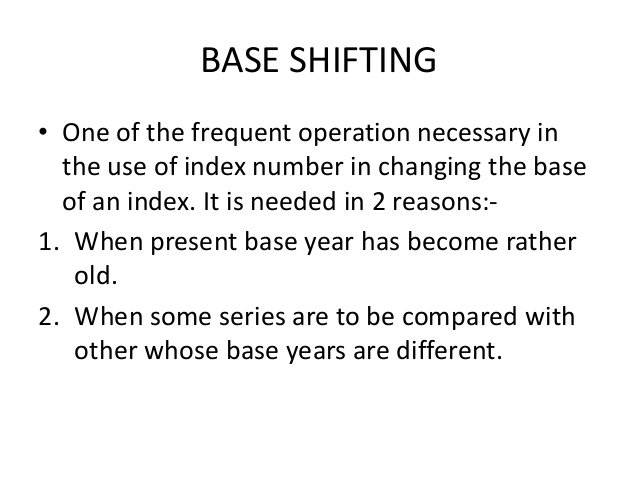Base Shifting
For a variety of reasons, it frequently becomes necessary to change the reference base of an index number series from one time to another without returning to the original raw data and recomputing the entire series. This change of reference base period is usually referred to as “shifting the base”. There are two important reasons for shifting the base:
- The previous base has become too old and is almost useless for purposes of comparison. By shifting the base, it is possible to state the series in terms of a more recent time period.
- It may be desired to compare several index number series which have been compared on different base period; particularly if the several series are to be shown on the same graph, it different base periods; particularly if the several series are to be shown graph, it may be desirable for them to have the same base period. This may necessitate a shift in the base period.
When base period is to be changed, one possibility is to recompute all index numbers using the new base period. A simpler approximate method is to divide all index numbers for the various years corresponding to the old base period by the index number corresponding to the new base period, expressing the results as percentage. These results represent the new index numbers, the index number for the new base period beings 100%.
Mathematically speaking, this method is strictly applicable only if the index numbers satisfy the circular test. However, for many types of index numbers the method, fortunately, yields results which in practice are close enough to those which would be obtained theoretically.

Splicing
Splicing is a technique where we link the two or more index number series which contain the same items and a common overlapping year but with different base year to form a continuous series. It may be forward splicing or backward splicing. We can further understand this with the help of the table given below:
| Splicing | The index number of old series | The index number of new series |
| Forward | (100/overlapping index number of oldseries)× Given index number of old series | No change |
| Backward | No change | (Index number of old series/100) × Given index number of new series |
Deflating
It refers to the correction for price changes in money wages or money income series.
Inflation adjustment or deflation is the process of removing the effect of price inflation from data. It makes sense to adjust only data that is currency denominated in this way. Examples of such data are weekly wages, the interest rate on your deposits, or the price of a 5kg bag of Red Delicious apples in Kashmir. If you are dealing with a currency denominated time series, deflating it will extinguish the fraction of the up-down movement in it that was a consequence of general inflationary pressure.
Real Wage = (Money Wage / Price index) *100
Real Wage index no. = Index of Money Wage / Price index
One thought on “Base Shifting, Splicing and Deflating”